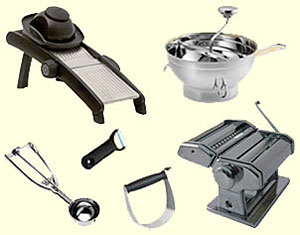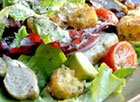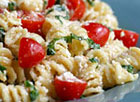Cooking Tips
Through the years and through trial and error, I have learned some helpful tips to make food preparation easier and help to save time effort in the kitchen. and make preparing food a more pleasurable experience. Anything that can save time and frustration is always good, and will make you want to experiment in the kitchen more often! This list of tips will continue to grow as they are remembered or discovered, so stay tuned...
Baking
Cookie "Pressing" - When cookie recipes call for 'pressing, squashing or smashing' before placing in oven, keep a small bowl of water handy and dip fork, bottom of drinking glass, or whatever tool you use into water before squashing each cookie. This will prevent the fork or glass from sticking to your cookie dough.
Cookie Storage - To soften and bring chewiness back to cookies that have gotten a little hard after sitting at room temperature for a couple days, reheat in the microwave for 15-20 seconds just before eating them. This will warm and soften the cookies, making them more like when you first took them out of the oven.
Cookie Test - Before baking an entire batch of cookies, bake only one cookie to see if it turns out as it should. This will help you determine if you should adjust your temperature, use more or less dough per each cookie, cook for a shorter or longer time, etc.
Cooking Time - Because ovens may vary due to calibration settings, set timer for shorter cooking times to make sure baked items aren't overcooked. This way, you can check doneness towards then end of cooking time to prevent overcooking. Example: For items that bake quickly such as cookies, set timer for 2 minutes earlier than recommended baking time. For items that take longer to bake, set timer for 5-10 minutes earlier than recommended baking time.
Oven Temperature - Convection ovens run hotter than conventional ovens. When using a convection oven (on the "convection" setting rather than "bake" setting), reduce your oven temperature by up to 25°. Cooking times in convection ovens might vary as well. You might want to check your particular convection oven's manual for more details and optimum results.
Pie Crusts - Dull, dark, enameled or glass pans will generally produce a browner, crisp crust, while shiny metal pans will produce a light, golden crust.
Breads
Yeast - Hot water kills yeast. One way to tell if the water temperature is right for yeast (without a thermometer) is to pour the water over your forearm. If you cannot feel either hot or cold, the temperature is just right.
Kitchen Tools
Storage Containers - Stock up on storage containers for leftovers. Sometimes recipes make more than you or your family needs for one meal. This is a great way to stock your freezer with ready-made meals!
Miscellaneous
Experiment -Trust your judgment and experiment a little with spices, sauces and other ingredients (tasting while you go). This is the way some of the greatest recipes were created! Only you know how you like your food, so don't be afraid to be creative.
Seasonings & Rubs -Keep homemade seasoning and rub mixes such as toasted sesame seeds, cinnamon and sugar, and meat rubs in jars so you'll always have a ready-made plentiful supply for your food preparations. Empty plastic Parmesan cheese containers are great for storing such ingredients, and even have little holes for moderate pouring!
Stubborn Jar Lids - If a jar of sticky substance such as jams, jellies and preserves, syrup, molasses, honey, butterscotch topping, Hoisin sauce, etc. gets stuck because it hasn't been used in a while, run the lid under hot water to loosen the sticky substance inside the jar lid. If it's still tough to open use a jar opener (as shown on the Kitchen Tools page.
Organization
Back-up Inventory - Keep a back-up supply of frequently used pantry items, and replace that back-up supply as soon as you remove it from the pantry to use it. This will save you endless frustrating trips to the grocery store to pick up items you didn't realize were almost empty.
Labels - Buy some stick-on labels that can be used in the refrigerator and freezer and use them to name and date your foods.
Plan Ahead - Plan your meals one day up to a week in advance. Much of the hesitation to prepare food comes from the decision-making process. Planning your meals when you have some free time is more enjoyable, will give you time to shop for the ingredients, and will take a load of pressure off when it comes time to prepare your meals.
Preparation & Clean-up
Chop, Slice and Measure - Chop up, measure, etc. all ingredients before you start cooking food. When you're ready to start cooking, there is less pressure and everything runs much more smoothly.Clean-up - During those times when you have a waiting period (while food is simmering, marinating, etc.), do as many dishes as you can. It's so great to sit down for a meal, knowing most of the dishes have already been done!
Ingredients - Get out all ingredients before you start cooking food and place them all in one area near your recipe, then double-check to make sure you have all the ingredients listed in the recipe. This saves you the frustration of running around your kitchen grabbing ingredients as you go.
Fruits & Vegetables
Lettuce Head Hearts - If you plan on using an entire head of iceberg lettuce, it's easy to remove the heart simply by banging the lettuce head against the countertop. This loosens the connection of the heart to the head of lettuce, allowing you to pull the heart out all at once. You then simply run water through the hole left behind by the removed heart to clean! Mashed Potatoes - To make mashed potatoes extra white, add little vinegar or lemon juice to the boiling water before draining.
Onion Smell - To remove onion smell from your hands after handling onions, rub a little fresh lemon juice on your hands.
Onion Tears - To avoid tears when cutting onions, try cutting them under cold running water or briefly place them in the freezer before cutting.
Vegetable Odors - To cut down on odors when cooking cabbage, cauliflower, or other vegetables that produce unpleasant odors, add a little vinegar to the cooking water.
Soups & Stews
Thickening Agents - There is more than one way to thicken your soups, stews and chili. The trick is to add thickness, while not adding unwanted flavor. One method is to stir in small amounts (1-2 tablespoons) of instant potato buds (also called potato flakes), stirring in between each addition, until you reach the desired consistency (make sure you wait 2-3 minutes before adding additional potato buds). For chili, cornmeal or corn flour can be used in this same way (though with corn flour, you'll want to mix in smaller amounts with each addition - about 1-2 teaspoons). For creamy soups and stews, you can combine a little flour or cornstarch (1-2 teaspoons) and a small amount of the soup or stew broth in a small bowl, mix it up until smooth, then add it back into the soup or stew (flour and cornstarch are not recommended for chili, however). When making bean soups or chili with beans, you can smash some of the beans in a bowl (or blend in a blender), then add them back into the soup and stir.



